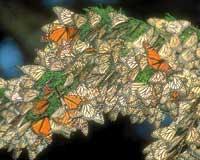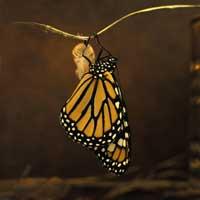Where are you going as a monarch?
The trees of the Mexican forests, especially the eucalyptus trees, have begun to get rid of the summer green and dress in red and black. In fact, millions of monarchs traveling from Canada to Mexico to spend the winter are ending the long march of red-black butterflies. At least the first round has reached its destination and the rest, about 20 million euros, will arrive before the end of the month.

But, as we have said, they find many obstacles in their career and, in reality, with such an intense color it seems normal that there are many enemies. But we will not fall into prejudices of appearance. Nature usually does things right and one of its laws is that colorful plants and animals are poisonous. And in the case of the butterfly, although it is not poisonous, unless you want to have in your mouth disgusting flavors, better not eat!
This butterfly places eggs and larvae in the asklepiade plant until the butterfly is adult, the main power source. But this plant absorbs not only food, but also protection for life. In fact, most asklepiad species contain a poisonous substance that is used to have a bad butterfly taste. Consequently, it is a little predatory animal. However, that doesn't mean you don't find obstacles through a long journey of hundreds of kilometers.
Not missing enemies
The main enemy of the Monarch butterfly, like many other animals and plants, is man. Collectors, farmers, foresters, promoters... all complicate their lives.
The alteration of the environment and the loss of reproductive habitat are the two main factors that question the survival of the monarch butterfly. As already mentioned, monarch butterflies place their eggs in sclerosis plants, but as these plants are poisonous to livestock, man has classified them in the list of harmful plants. Therefore, unlimited herbicides are used to remove these plants and for monarch butterflies it is increasingly difficult to find an appropriate place to lay eggs.
On the other hand, the Mexican forests are increasingly exploited and to pose in the winter pass tree, butterflies have to go higher and higher on the mountain. However, Mexicans wait for the butterfly and every year, on those dates, the children of the mountain villages dress in butterfly and make them many welcome rituals.
Genetically modified corn, new enemy?

As if it were not enough with these obstacles, in the last five years, the butterfly meets another enemy not harmful in its appearance, more specifically the larva of the butterfly. During its migration, the butterfly crosses the region of large U.S. cereal, known as the Corn Belt, and as is known, many of the seeds that are sown are genetically modified. These seeds have generated great controversy, as some believe they can be harmful to human health. And so much has happened in determining whether the monarch is related to the mortality of the butterfly larva.
The first study to determine the damage they cause to this animal was conducted by researcher Losey in May 1999. According to this study, the pollen of the genetically modified corn of the Norvatis house affects the larva of the monarch butterfly. The results of the research had a huge media impact and after the controversy, the monarch became the butterfly symbol against genetically modified plants.
Corn is genetically modified to protect it from an insect called pyrale. But genetically modified corn makes no distinction between insects, so it also affects harmless insects. One of those affected may be the monarch butterfly. Research conducted in the laboratory revealed that ingestion of cardinals in leaves coated with genetically modified pollen resulted in the death of 44% of Danaus plexippus larvae. The investigation led to intense reactions and the European Commission ordered, at least within a period, not to use genetically modified corn.
But not everyone agreed with the results of this research. According to scientists who show a favorable attitude to genetically modified plants, this research shows nothing. In his opinion, the real enemy of the monarch is the insecticide, which prevents the use of insecticides. They also denounced that these experiences were carried out in laboratories and therefore did not reflect reality.

To respond to this latest criticism or, in August 2000, a group of researchers from Iowa University conducted a new research, this time in maize areas. The results of this study were as follows: "The influence of modified pollen on the monarch can be seen at a perimeter of 10 meters from the cornfield."
However, the turn seems to be as long as the path of the butterfly, since just finishing an investigation comes out another that belies the previous one. According to a study published by the American Academy of Sciences this fall, the monarch butterfly threat is not the cause of genetically modified corn. The first objective of this research has been to check how much monarch there is in the pollen period.
Although the data vary by region, the political era and the presence of the butterfly are synchronized between 15% and 62%. On the other hand, they have realized that in the corn plantations of the eminently agricultural regions there are many more cardinals and, consequently, more larvae. Although, in principle, it can be considered a positive fact, the research does not specify how many of these larvae survive.
We have already reached the chapter of the story between the monarch and genetically modified corn so far, but from now on we will have to wait for the echoes of the debate to come.
Protection measures
The protection plan of this butterfly was launched in 1986 with the designation of an ecological reserve to winter in Mexico. In 1995 an agreement was signed between Canada and Mexico and it was agreed to create a network of international reserves for the monarch butterfly. In addition, three regions of Ontario were declared butterfly reserves. In 1997, the Mexican government presented a comprehensive program that would include, among other things, the creation of an International Exemplary Forest.

Other programs aim to reduce the use of herbicides and eliminate from the list of toxic plants the plant of asklepiade, so important in the butterfly cycle. On the other hand, in order for people to know this butterfly better and explain its situation, several campaigns have been carried out since 1992. The first campaign, called "Monarch Watch", was held in Texas in 1997. It was a program of great importance as it coordinated the studies of stable isotopes to know the evolution of butterflies.
The analysis of isotopes helps to know in detail the path of the butterfly. The isotopes of hydrogen, carbon and nitrogen vary from place to place and these remains denounce the trajectory of the butterfly.
For the same purpose, in 1992, the Canadian Nature Museum organized a travelling exhibition on the butterfly. The exhibition was very successful and, in short, the updated data is about to start a new round. However, whoever wants to see the exhibition will have to travel to the other side of the Atelic.
Published in the supplement Natura de Gara.
Buletina
Bidali zure helbide elektronikoa eta jaso asteroko buletina zure sarrera-ontzian











